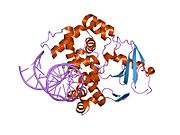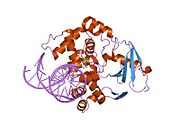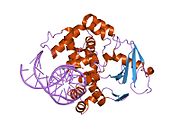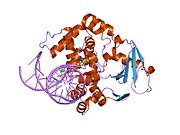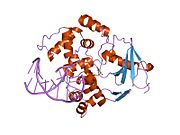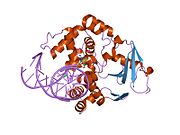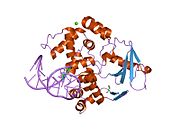Oxoguanine glycosylase
| View/Edit Human | View/Edit Mouse |
| 8-oxoguanine DNA glycosylase, N-terminal domain | |||||||||
|---|---|---|---|---|---|---|---|---|---|
| |||||||||
8-Oxoguanine glycosylase, also known as OGG1, is a
Function
OGG1 is the primary enzyme responsible for the excision of
Despite the presumed importance of this enzyme, mice lacking Ogg1 have been generated and found to have a normal lifespan,
Increased oxidant stress temporarily inactivates OGG1, which recruits transcription factors such as
OGG1 deficiency and increased 8-oxo-dG in mice

Mice without a functional OGG1 gene have about a 5-fold increased level of 8-oxo-dG in their livers compared to mice with wild-type OGG1.
As reviewed by Valavanidis et al.,[14] increased levels of 8-oxo-dG in a tissue can serve as a biomarker of oxidative stress. They also noted that increased levels of 8-oxo-dG are frequently found during carcinogenesis.
In the figure showing examples of mouse colonic epithelium, the colonic epithelium from a mouse on a normal diet was found to have a low level of 8-oxo-dG in its colonic crypts (panel A). However, a mouse likely undergoing colonic tumorigenesis (due to deoxycholate added to its diet[12]) was found to have a high level of 8-oxo-dG in its colonic epithelium (panel B). Deoxycholate increases intracellular production of reactive oxygen resulting in increased oxidative stress,[15]>[16] and this can lead to tumorigenesis and carcinogenesis.
Epigenetic control
In a breast cancer study, the methylation level of the OGG1 promoter was found to be negatively correlated with expression level of OGG1 messenger RNA.[17] This means that hypermethylation was associated with low expression of OGG1 and hypomethylation was correlated with over-expression of OGG1. Thus, OGG1 expression is under epigenetic control. Breast cancers with methylation levels of the OGG1 promoter that were more than two standard deviations either above or below the normal were each associated with reduced patient survival.[17]
In cancers
OGG1 is the primary enzyme responsible for the excision of 8-oxo-dG. Even when OGG1 expression is normal, the presence of 8-oxo-dG is mutagenic, since OGG1 is not 100% effective. Yasui et al.[18] examined the fate of 8-oxo-dG when this oxidized derivative of deoxyguanosine was inserted into a specific gene in 800 cells in culture. After replication of the cells, 8-oxo-dG was restored to G in 86% of the clones, probably reflecting accurate OGG1 base excision repair or translesion synthesis without mutation. G:C to T:A transversions occurred in 5.9% of the clones, single base deletions in 2.1% and G:C to C:G transversions in 1.2%. Together, these mutations were the most common, totalling 9.2% of the 14% of mutations generated at the site of the 8-oxo-dG insertion. Among the other mutations in the 800 clones analyzed, there were also 3 larger deletions, of sizes 6, 33 and 135 base pairs. Thus 8-oxo-dG can directly cause mutations, some of which may contribute to carcinogenesis.
If OGG1 expression is reduced in cells, increased mutagenesis, and therefore increased carcinogenesis, would be expected. The table below lists some cancers associated with reduced expression of OGG1.
| Cancer | Expression | Form of OGG1 | 8-oxo-dG | Evaluation method | Ref. |
|---|---|---|---|---|---|
| Head and neck cancer | Under-expression | OGG1-2a | - | messenger RNA | [19] |
| Adenocarcinoma of gastric cardia | Under-expression | cytoplasmic | increased | immunohistochemistry | [20] |
| Astrocytoma | Under-expression | total cell OGG1 | - | messenger RNA | [21] |
| Esophageal cancer | 48% Under-expression | nuclear | increased | immunohistochemistry | [22] |
| - | 40% Under-expression | cytoplasm | increased | immunohistochemistry | [22] |
OGG1 or OGG activity in blood, and cancer
OGG1 methylation levels in blood cells were measured in a prospective study of 582 US military veterans, median age 72, and followed for 13 years. High OGG1 methylation at a particular promoter region was associated with increased risk for any cancer, and in particular for risk of prostate cancer.[23]
Enzymatic activity excising
An important effect on cancer is expected to derive from the drastic enhancement of gene expression for certain immunity genes, which OGG1 regulates.[26]
Interactions
Oxoguanine glycosylase has been shown to
Pathology
References
- ^ a b c GRCh38: Ensembl release 89: ENSG00000114026 – Ensembl, May 2017
- ^ a b c GRCm38: Ensembl release 89: ENSMUSG00000030271 – Ensembl, May 2017
- ^ "Human PubMed Reference:". National Center for Biotechnology Information, U.S. National Library of Medicine.
- ^ "Mouse PubMed Reference:". National Center for Biotechnology Information, U.S. National Library of Medicine.
- ^ PMID 10233168.
- ^ EntrezGene 4968 "OGG1 8-oxoguanine DNA glycosylase"
- PMID 11902834.
- PMID 10557315.
- ^ PMID 12615700.
- PMID 23284747.
- PMID 27756845.
- ^ PMID 25024814.
- PMID 16024598.
- PMID 23985773.
- PMID 24951470.
- PMID 24884764.
- ^ S2CID 32537522.
- PMID 24559511.
- PMID 26785117.
- PMID 26980051.
- S2CID 54278905.
- ^ PMID 23902537.
- PMID 27186424.
- PMID 12953085.
- S2CID 23247597.
- PMID 38201575.
- PMID 12933815.
- PMID 12034821.
- PMID 24698998.
Further reading
- Boiteux S, Radicella JP (May 2000). "The human OGG1 gene: structure, functions, and its implication in the process of carcinogenesis". Archives of Biochemistry and Biophysics. 377 (1): 1–8. PMID 10775435.
- Park J, Chen L, Tockman MS, Elahi A, Lazarus P (February 2004). "The human 8-oxoguanine DNA N-glycosylase 1 (hOGG1) DNA repair enzyme and its association with lung cancer risk". Pharmacogenetics. 14 (2): 103–109. PMID 15077011.
- Hung RJ, Hall J, Brennan P, Boffetta P (November 2005). "Genetic polymorphisms in the base excision repair pathway and cancer risk: a HuGE review". American Journal of Epidemiology. 162 (10): 925–942. PMID 16221808.
- Mirbahai L, Kershaw RM, Green RM, Hayden RE, Meldrum RA, Hodges NJ (February 2010). "Use of a molecular beacon to track the activity of base excision repair protein OGG1 in live cells". DNA Repair. 9 (2): 144–152. PMID 20042377.
- Wang R, Hao W, Pan L, Boldogh I, Ba X (October 2018). "The roles of base excision repair enzyme OGG1 in gene expression". Cellular and Molecular Life Sciences. 75 (20): 3741–3750. PMID 30043138.
- Vlahopoulos S, Adamaki M, Khoury N, Zoumpourlis V, Boldogh I (2018). "Roles of DNA repair enzyme OGG1 in innate immunity and its significance for lung cancer". Pharmacology & Therapeutics. 194: 59–72. PMID 30240635.
External links
- oxoguanine+glycosylase+1,+human at the U.S. National Library of Medicine Medical Subject Headings (MeSH)


